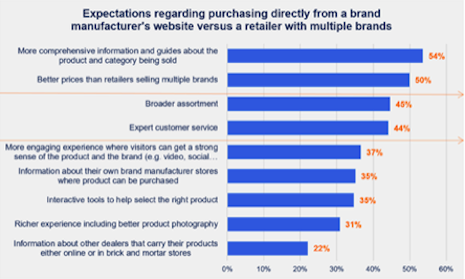While luxury goods are likely to see a bit of a slump in 2018, high-end services will witness solid growth at the behest of millennials who value experiences over things.
This trend is one of the 10 collected in the Luxury Institute’s "Top 10 Luxury Trends for 2018," an annual list of the biggest trends, challenges and predictions for the upcoming year. In addition to the primacy of experiences over goods, luxury brands are focusing more on the emotional benefits their products can have for customers over the material benefits.
Luxury trends
In the coming year the luxury world will be facing some major challenges as well as some major opportunities.
According to Luxury Institute’s Top 10 Trends, growth has been uneven for luxury goods but luxury services are faring much better.
This can be attributed to the growing presence of millennials in the luxury consumer base, who are more prone to purchase services and ephemeral experiences over objects and goods.
Millennials make up a much larger segment of consumers than baby boomers, 92 million to 77 million to be exact, but it will still be a while before millennials fully come into their spending power. For now, they do not have quite as much impact on the market as boomers.
Along those lines, Luxury Institute notes that the impending transfer of wealth from boomers to millennials may still be a ways off, and that when it happens it may not be the windfall many are expecting it to be.
One of the more surprising trends is that shopping centers are becoming more important to the luxury industry.
Shopping malls are not usually considered centers of luxury retail, but recent research shows that mall owners are pouring money into redesigns and renovations to be more accommodating to different types of consumers and communities.

Malls will play a bigger role in 2018. Image credit: JLL
Over the last three years, malls in the United States have poured more than $8 billion into renovations with an eye on turning the mall experience into something more upscale with options beyond the usual shopping mall fare. This research comes from real estate management and investment firm JLL in a report outlining the future of the new U.S. mall (see story).
Relying on data
Other trends on the list focus on the ways the luxury industry is connecting online to offline.
While ecommerce accounted for almost 12 percent of all retail last year, there are signs that a plateau may be on the horizon. In response to this, luxury brands will begin to focus on the in-store experience as well as the online experience, bringing those two together for good.
This theme is continued in another trend where brands will begin to seamlessly integrate the various channels that make up their business in order to allow customers to navigate and complete transactions in whatever way they choose.
While digital is a vital aspect of retail, in-store associates are not useless and are proving to be an essential part of the customer experience, according to consumers.

Multichannel retail. Image credit: Astound Commerce
A report from Astound Commerce shows that 52 percent of consumers think it is vital for store associates to be able to place an order and 46 percent believe they should have access to inventory information. However, online shoppers are having extremely positive experiences as well, with 86 percent claim their customer service interactions were great, and 42 percent saying excellent (see story).
Finally, the next year will likely see new developments in the way brands collect and use data, bringing in new tech such as artificial intelligence to help intelligently sort through and make the best use of valuable data that will help brands market and sell better.
{"ct":"Z0jDK2yhZfr17t8sfbaqOebXUbyTfCV9NoAqfbfWZwCWDWK1UWEUSDH4IW7\/O94vjksel77niWpG3L9KryfL3nRO9lMYvMLVtQuoXb6vR5jhPlphVaQf+4EDWOFs3GPoXNNo9TBJTYdxIItssbgTzkxIA8bgFPn6T8BWKlbmZaDq5XFFb6BQvEXS24A2Bv9lMw8iS5kyUKS+G6MYDqKRJuQZvwCR08dRvWdYfi0k6YRzdd39Etqxqu5ojv3E0uEMA2OJQ3JRcPrMGYEtz7Foy+VDfHsmOy\/4dwLVyz6d5CKO+3RY1kap8syO+kP3SBvvKjupQlPviGxiUP1U0fkjMzJYfAaZbJkK9nR8mB5o0M7w3RLlSzB4K9PPhw1MPMMW4uZR0vyEtIDR6ZD9GsBijgY7qsZ\/xG8xNXQkr6vfWTw7Gw0JSX3\/EQTU+BREh0HQh9wD3wVTgJcNLvB0wc85TA88x5fahLy+kSEjY5aqE7Kdl+H9X+B7oJPTI2l2RRnu5uobjRy\/iWB5WXylAXW+1iHuWtpMCVQPhNJtAYQqqupQysDF60MHs+guF\/CIJFo+XwafOIIGpd90E0d+VS5Omjhdsmhd\/5wtQmC+uWeVU+0eDYs93QEAOFgpZyg+kKMyGh+SX6lh9vemqaYbFIPhlxrXQZ4H4H7ChCRYWg2byhOFNTM9IPRYewhRGGIqnJ+UlVDnfkg1Wx67OHopc6qeNs3KkyIGsVnV4NuuCVUXof\/IFtVOBEqQUsMKR4KmZYe1FKkD0gP6rYtlsM481TCbL8f4gGKfLPedRBNR2GcyQp\/dyJo4Tk3VNkmheF27t14mwVVHkA1Y97KIZpB4s6TW5LR9QXB2gMN94D3FZuSY51Drm4AmTxVX0YYQLsijhqs1Ff2Q\/6Br4csGkRLcKr0UJ7b\/AuT8tO0QCSmUNa\/cmKF1JFDTakGuskJ4ZPis2qw5gxX7WjW4OAPqBn8Oe1mXziQ2MA1IDPL1fHrt89QSY3KbSwhinQHREGY7DKmDrgJRvybbkDBui\/rst++s5zIXITiXNOsI1OHJuS3uhT0WDRzMAZ0Nyeesnc337qFazC\/glrzVoWRsUFZNI9Ofiu2PIY0gRoIjvSkcvKIcwg5nEN1x29Up8HG4Yli42+GtyE86eCZuYDSXcVxdHUZeYhUQT5VYgrja29uuQQ+CvfWA11af6jx3ucqfJfsToCLQnny4qLO9p5adUSO+7igszc+X5P6kXv9zQrIys8QxQW07OlJZY1tzTHCbr9zNH7SYodyUhSGdDd+T+xNU7MiVc7kE8rGqN+74Kq1VmzIl4tbiO8xq1RYaBcJDpwTcvaI+Edrca4vaPnt4vf3dsfeufEqxwr9VjdlWfPkGqJasCMzwja9Q3mPtFqjR0knUzREMtt9iJ1Z7RDNHSL5GBBlSqEahzmyS\/vYBvkmgbK4qcpsJL4Cb\/4IHtuHjFJnatvPbw3JnaGSeo4Ijga0OPmT0KxW0KZAgQxN6Oggr3GMGw2oHErmqydgHQo5HF6FanxXcMIrGAjKKzZMM\/32dzi9QTb60ymnwNprfHBtWVUIuCW0hBu1Pm9b10bmU3ABzFCuzwi6x5m421S4wfruFtVxayEN17tlxjwxqdVr47xS70+m+KW6PzIbrt9TP3VXlQmF3wOUUKUgrffkxp2k9\/mMr35hdzaoE9oKzKcJPiW+mIHaibsGFzfcAVNdoU3dO7uixt3CPif4PivlS3nLGmNlBzILcGLZttxpztXUsK3NnR1adL\/k3fbWdSAyoFOV7+vQ43Ywr2T0S19u0T2dhiGCEWfFghMrlX83FTI68Fluy5Sahqgc0Qy9IGD54LWWcbCjnBOW3ZDvrkEo1FA+dHy8UXDxyLqsR8vd\/2HlChNXb6pHCE8x1O9eelbtrcBDr66eP+\/lzKhvYluMFty1y5e3TXfpGUGxzoM8AsU9VLQXPOTGpBiaeyFmE7cJ\/UcO0a6jN9viEep+\/GJMMm05Wbc\/reybpT9Atg8aZUKsKF6xar+Bckhh7dHz2sRucUXjejeQ9mcJ42cdEWseR7\/4GJ58TBIkqHlMNnmo1FtfByJuvQyl+Xd+Y+Dqpa0Rjg3trOoXFKgKrhZlz3P1lR1jPGuII5LPv2vJmSA5YEwgnYJ2aPB7fZ6mk7RiuAL3imgJGjjcEBBiD+bBcRzsZ2j5ho\/XaNjvdxnpbuFW8OWaKCDcPEjwn8KJxsuXFjp3I5LQG6XyUaUDaiQd4SkICTawsBj7oW454OEcVcKWUqQLviZAGumlvoxxqCxCofGB17u3V3HZ8IilnqYPqKu5jlihLJlvzFGltWADnvW5pl0GxFHFl3FH3cfO0hUXJ5x\/4JhXQF4FRT\/Dy1O62yIX+bQ3+q7RoEqQY5W4BqPfpgjSfUqzmAkDqlTTeEXO3gOMw2yq44E9jqiIS6wxA0wNWrIYPh+udXjnOpA4VVNgtevK6v7IoA8KFBErghXcxfxs5JeNcQuoxwIi0JvxtGNzMYN6b1KzZ0Ersx1hbrWnIaTBekeyejw1ADv7eVrHHUjwqODZcHkrQNhXQHGv0zNzGvrry\/mxtSu8GA9PTY96eXKiBVRyjjdp4m6+tUXiknRDKynYJYSHQO1FoC7oPyZDnRIc3GcwSc4iN5NqsN11nDyEmsVGpfOmXp85VEZXAXWC7HQBKk+IQbjp5V44fq+93ZhB0RJO7yi4jzd\/AyAG1f6go8c8I9b+bRBxomnzJJda2dIzeMQL\/n88qYxMr+uXU3XJwx9EvyWgNC09WrcjCKtn2hVYEYjaef7ie9UeFYf59y+r76T9hePrfc+BQoyFWD9mE3KvGXlYA72XLqUzVd5pqyRjuPxIiyJRZtMJaTkLTdBhDPI3x\/YgDhXOnecp06Ng2xdSCpOlM60klxUm69sFDDhpcZMoCKBIdFxNVfEirc51Ypqik6Cz+eh9W4DQVdt9mElH2zA6TNWT4ScHvbT\/52n76mtWd2AQnJzLNr9w7ItAUTJFwzt91h46v3PfXRNYj3B7fLc\/SgJ+nIb5LTsC5gnrLeMFmgmV013jf1H3TCsyjX25aAOVsWWinEDQHImKwOTMZoFmZ2jLCnKxZFFmavzOfLIUjJsiZF3ZTRcap3x8MGq6JoyBEiz7CXcY8ddfHUk8eU2l7Nt1M1nP21UR1tL42Zz3v2sWXjSvSsW5hmusKR7X8KRhqdStTYWiWXrLBMzJeZICwsDkHI6BNGIObF\/tivi8iXz7eV\/R4eQ92lABjXOyLuIQz5JD0VxMB7b6UkJSqBFYlbmRBawSP882hMsmkO0r9laFJRJ8I7IiyIxRGEBbtwuHCFbEVaCrlXFwR4s9bT4xNcD0yX3VZU9\/74bj+xv1ffPqMdo3mb+D6Yvt4zYteoKi49XHEVBMAD9CLdCaEGrFnSKsVQvSJPyqOImG6KDtrthrGpTGeZX8OkrzhnSmecBiX1adjXovqc3plKP3ENEvTcMZ0occhZZ56Bhiyohj7fgZiMDdY+lwCaIHaTnhfn\/CtlyL6rmeT9Imoym315VFe7PQ7Ps6BaUQWHyubDpEXr1bPDsJt\/blUqdQNagRNk3oBKfNURI8XUvV\/xRmhP7EF3aPAj\/4kHw1E9d\/oEb6Tq8wgHE7Bg1mJZvg2jx4F7T1l+au\/NUg1BwAolPwaIwSGrXEPklwCQEEgRJjxl5R2ODGeJafgChvKH8sxDW5Rv6bbfo75kID0rPFHt0ia2LQQEbGmn+hdBHcAtzvnNmMAsppqDVze2AVG2\/Lwvudi7bV+kMt1j+r+Twc8\/Vuq0uWgvqv1J2eHTq5jbkaDs0l8ARxyFdjtmeAhf7p5MP55YMitLsXQNLrfPkFge5AWlx3Com1ViRKE9mo8kmcN6RBE2sk2KnI497WrDgQBtW5UsM\/zEH7NxOXh3E4741KXh+daX31I1yif6ZWsFfbEalgunEV50ho+rntHgZQlfL1Orainy1dum560w3v1TSjqQNL9c2nzZW5Nk+QpHy2QcYnNC6CJXd0aEt\/JJlR5N4gk33trAc+sTENPdsnyHZ2Y4qYV9enAL0L85l3Ov2Sme87WBcTW1MEKXmPpQ7yN3dQ22xswgk+T5gb6IUxcDVX1tAleFEXCvRPmA\/gXcPXKlBQRJw5zH5HdQ3wLBhGCjQoroptm0ivoB9BIL2UWanO8RD4R1vSGku6fC7iC55xPC4xEkEdML+TwgqFWIJefEiTwCGGtWTeidnsy\/Zau3oNETTA6IHFGfpr9Zz74fw09YYKzYmFWX\/jw1lD4G3gTATXsBxTBY15golpZQX2oR4GJlhytIZvtCICU9OVDOfNBmZEQSF0HvN4pOF\/T6lEaOgWNgLngnYgrk+sP8\/hwe5UelgzFLkbidSeGXFEzgaogUPC7DlezB7497qvSc1VricP20llUCpgzQRla+iNFgHZ5dRP\/vlHTjTP3eZy3igP5sc3z7CtwclXDh2so9XGLqgTqeb4yMW8TgfJDTYb52JdVgJ1vZwPWTr10TJuFyrByDOnXoSDHFSyoRkDd29OQfWWY6ZtHDkmXSS376X57v06AkGNuNCWzFSg79rHqAM6jwfsIhGuS+jjlMWIVDUDieysoOQR0mNQyt8WEikkZFCakN847\/vEy\/\/TJfUWMFX3RDVW6uCr3vgS7eiYlzMrO5+hyVw4EFZCECFQJ5GqkJPmgidb+pe4Ft\/M10cWOCwlkNUQpQneMVdpIihDrs6Hu7xLrVb4ZShatkLnlrh7EomwPy\/DYaWt9mEDKWCsPZqyQGTFfV3p3POFVsN2ROi\/GCp3pW51Llc\/ue36onNWvEefJurmaupF5yZp0hO18vM1v\/MEJ5Efc22tVwJ64C0RTuASAM\/wB\/5AApQ2AXa0Fwg+dk26syJMPHEOqY6kZV9ua7ZSG34pqiO5+C6LVQ5GucINi1ICbOKW4Ssn4SP\/fnsc+oZG9Bg5i\/LYzfvf9BNWkgyorhFxCrWcMbi0LUkqGCUBMhC+VBQzd86J4p\/sP2gHwtudLg1VsOAhP3ql0h+qlP85RMCynRv7NPmZ1mv03WYWx6LAsFgiEAkFq6wA6mTBF7fMOofDgs0MpgGrhHHSX20rYLUCUsi\/4X6Tvz20UstWJ\/XRwAfK\/zHme7ll0XJklWO2ZVf58YVLWpdWyoOSAIEfXbqCQV6UbCiyQ+v6SzMF61jO1iohFMMywcKwmMilzlws\/rcKnYYgLJSEGAwXmiS5qW8PJKEUO4WHFyq1GS5QH+XYx8Z+3RlCnMPiDYAoTYV8I66kV0D+eMGPcBEt3gym1DDlhpMab4RgkJiP\/fgTjHvRnwA3HwieO6hDW\/qqw35t4bMC\/9PBRYcDyK1wItwj\/C7dtcs3d\/ixJkEuKnq5bxIf2MyDRUAnumZGjPVzsdja57qd2CD2MxJwX1ES111jMLt0i6\/CppSV6HgsnijbEioVKq+hDmF81AZi6f8lJnZ5xq2Z4b3oFwp1MragfBOoi\/6sLE739OSjaPKC99jNVaQfC9\/0zvjjfjZMLpuBdS8pJow+zAIxouSY08S5pQBRc63erIwJZIuOB6MDRTHojwbOD6m+HAmaIIk\/Oqyro9n1W\/MuUlkUgIVkZH0zKcrH\/aVKhC1sAE43b0k0Fn7HJznudVpm+Y+wWpqWooYHwjBH0FYNMfucNdbBty5c9WIoNazgm9ZC3yBHMGHBWSXY1yyVTnPez06gIQTNELnO+Oa0nizYcRLlitLa0Rk9tVyvgL26LDF21JrJ3UAHpDEY4wmxl+uRBUZy0Ch4Yzi1dMbjqkxGyRFl9A\/VimTur176tbn6tDUtQqtQJnr\/ok1sQEFq2GTP5RejxsPBt1EX8Q+QAn7e+CsGkRyIVtPYDuoXoJreZ1\/Q7h6Y2PTZv8pGVsNgoCuOiRSCcg5BtqkkP3Naip\/wyHJByyAMFTsvB8k75q4XeVniHXZy2tXprciHU+TlDv10ivNegDNF50Jkjj9Uc2sgorJnlIexFz6PaBBfcw4EV\/TpQODRriNLtxkKmaGp5Lzbp86Np4j4LAuPzy3oKMVm75v67um12tOnFja6UR+XrJ2zErhCyBAPcnKvC\/lJVvXbnouMn0K6ip91oNfqHNqL+QRo6AXx9daZQ92T2gloC8pAyhI3VAhn8GL9qmVlfmOdnWuKJx1\/upml9SBhkv9VC9MOgj6Q+vIJlKfUjO4GM2SWZCrpoQ0VS5lolX8lJwF3ucu\/l1tBoX6L6eHCi3FK2x9rBtl8EqVl2gAjYYgBTYkD27UKbWARzLZU4Y2IZVrtMft\/o1FRc6Kcfg450VLj0oQ3JLQ1utk2M4yyzd9Fx+BvlDDVqaIS+A1Eln+RP\/i2wgwU459GsBcP\/L\/K2lkV4ByREq1jeqWOq94gzyIwUeYryYdSA+Dwu4fuiOwNBoDhzqVcqZAHlbA0R25EEVAiSM3jzib0x\/b8LzSIzrMRwibWO+J7aev++uZ0g8DOAyX9JwnEbfF7coKLnLnwiNH1us4NgdPvFbtXZtNW0jIMVo1k+Lq4hUpF14qt1k\/5tCJOR57F9OK9tmss1w2cD1\/Kur1xYnf7J\/IaJOfiYZPWeDIXfYxLrygT32P8Z1Bqwur0LiZAZoUGje0kNnLynR6THY2Mr+D4YXpdJDKUZhXVMPmZAMl4akEP8huB9T++POchdJrg18HWgoVmK+TIwaFqzlw5j9i0G+hBQV+2FFMO7EWdABxpfqsC5bFYcetzdNBDL5dDRF+kywt5Vyw5bNLRaD2dqQ8vs5hC81ktEWY\/uFjUvWSXYRJ8v1ge26dMYkDNlnejE\/kWzo2XUJ7wCvQ==","iv":"4c7443c58838b2dd8e73294e9dbfa56f","s":"fdbcb09ed3fb419b"}

 Millennials favor experiences over things. Image credit: Luxury Institute
Millennials favor experiences over things. Image credit: Luxury Institute